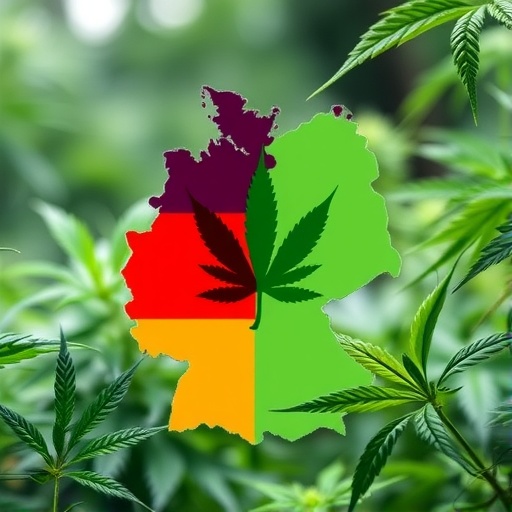In a groundbreaking study published in the International Journal of Mental Health and Addiction in 2025, researchers have provided an unprecedented glimpse into the complex landscape of cannabis sourcing in Germany shortly after the country’s legalization of recreational cannabis use. The investigation offers novel insights into the coexistence of legal and illegal cannabis markets and raises pivotal questions about the effectiveness of legalization policies in regulating usage and curtailing illicit trade.
The German shift towards legalizing cannabis represented a major policy transformation aimed at not only reducing criminal activity but also promoting public health and safety. However, the transition period allows for an invaluable natural experiment to evaluate how regulatory frameworks influence consumer behavior, product availability, and the interplay between legal and illegal cannabis supply chains. The study meticulously maps these dynamics through an extensive population survey and market analysis.
This research highlights an intricate dual-source system where consumers access cannabis from both legal dispensaries and illegal outlets. Despite legalization, a significant segment of users continued to source cannabis from illegal vendors. This surprising persistence suggests that legalizing cannabis alone does not immediately displace established illicit markets, which might operate due to factors such as pricing, convenience, product variety, or social networks that have been inherent for decades.
Technically, the research employed robust statistical methodologies to capture consumption patterns, purchase frequencies, and preferences across a demographically representative sample of users immediately following legalization. Sophisticated modeling enabled the authors to differentiate between various user categories, thereby identifying demographic and socioeconomic factors predictive of sourcing behavior. For instance, younger users and those with lower income levels exhibited a higher propensity to remain engaged with illegal sources.
The authors also delved into the regulatory challenges posed by the coexistence of legal and illegal markets. Legal cannabis products are subject to strict quality control, taxation, and marketing restrictions, intending to protect consumers and generate government revenue. Conversely, illegal products lack such oversight but often undercut prices due to tax evasion and reduced regulatory compliance costs. This economic disparity fuels illicit consumption, undermining legal market penetration.
Importantly, the legal cannabis market in Germany was still in its infancy during the study period, grappling with supply chain issues and limited retail infrastructure. These initial growing pains contributed to supply shortages, which, the study suggests, further incentivized consumers to turn to illicit vendors for more immediate purchasing options. The authors highlight the consequent policy imperative to stabilize and scale legal supply rapidly to meet consumer demand effectively.
The study also assessed user perceptions regarding product quality and safety. Consumers reported that legal cannabis offered greater assurance of standardized potency and contaminant absence but complained about limited product variety and higher prices relative to illegal cannabis. This dichotomy underscores the trade-offs consumers weigh when choosing between markets, influencing long-term consumer migration trends as the legal market matures.
From a public health standpoint, the persistence of illegal cannabis use presents challenges including potential exposure to adulterated substances and unregulated dosing. The research raises crucial concerns about monitoring and mitigating these risks through enhanced education and enforcement efforts. Simultaneously, it calls for adaptive regulation that balances consumer protection with market accessibility.
The study’s findings are particularly relevant as many countries contemplate or proceed with cannabis legalization. It reinforces the notion that legal frameworks alone do not eradicate illicit trade but must be complemented by comprehensive strategies addressing supply equilibrium, pricing competitiveness, and consumer education. Policymakers should consider multi-dimensional approaches incorporating law enforcement, economic incentives, and public health outreach.
The researchers also touch upon the socio-cultural dimensions, noting that long-standing consumer habits and social networks tied to illegal markets represent deeply ingrained behaviors that are not easily shifted simply through legislative change. Transitioning these cultural dynamics requires time, trust-building in legal products, and social acceptance.
Beyond the direct implications for German cannabis policy, this research contributes to a broader understanding of drug market economics and consumer choice theory under regulatory transformations. It highlights how consumers respond dynamically to price, quality, availability, and societal norms, reshaping illicit and licit market boundaries.
Technologically, the study leveraged advanced data analytics and cross-sectional survey methods that may serve as models for future research in drug policy impact assessment. The integration of quantitative and qualitative data offered a nuanced picture of emerging post-legalization cannabis markets, providing actionable intelligence for regulators and stakeholders.
As legalization efforts accelerate worldwide, the German case acts as a crucial early indicator of the complexities nations face in balancing legalization benefits against unintended consequences. The research warns against simplistic expectations of immediate illicit market collapse and instead advocates for evidence-based, adaptive cannabis policy frameworks.
In summary, this pioneering study elucidates how newly legalized cannabis environments negotiate the tension between legal and illegal supply chains. It underscores the necessity of comprehensive policy measures that simultaneously enhance legal market competitiveness, ensure public health safety, and disrupt illicit supply mechanisms. Germany’s experience offers valuable lessons, establishing a benchmark for future legalization evaluations globally.
Subject of Research: Legal and Illegal Sources of Cannabis in Germany shortly after the legalization of recreational cannabis.
Article Title: Legal and Illegal Sources of Cannabis in Germany Shortly After Legalisation.
Article References:
Manthey, J., Klosterhalfen, S., Kotz, D. et al. Legal and Illegal Sources of Cannabis in Germany Shortly After Legalisation. Int J Ment Health Addiction (2025). https://doi.org/10.1007/s11469-025-01574-3
Image Credits: AI Generated
DOI: https://doi.org/10.1007/s11469-025-01574-3
Tags: cannabis consumer preferencescannabis legalization impactcannabis supply chain analysisconsumer behavior in cannabis usagedual cannabis market dynamicsGermany cannabis market studyillegal cannabis sources in Germanyillicit cannabis trade persistencelegal cannabis in Germanypublic health and cannabis policyrecreational cannabis legalizationregulatory frameworks for cannabis





